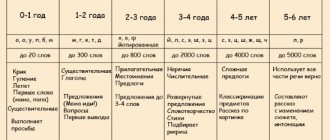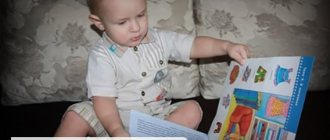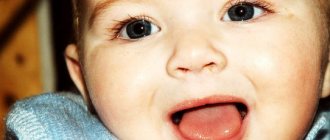The sound “L” must be introduced to the child as early as possible, namely at the moment when you notice problems in the pronunciation of this problematic sound. The older a preschooler gets, the less flexible his language becomes. It will be easier to overcome the problem “in the bud” than to later reap the “fruits” of inattention to your child.
Making the sound “L” involves using various methods of working with a restless and sometimes unyielding baby. This article is devoted to the independent speech therapy work of parents with their children. The article will provide mom and dad with the opportunity to teach their child to say the letter “L” and the sound “L” easily and quickly. Articulation gymnastics will help teach children to correctly say the letter “L” without the help of a specialist teacher. Treatment is divided into two stages: development of correct articulation and sound automation.
Setting the sound “L” when it is absent or replaced in the child’s speech with “Y”
At the first stage, correct articulation and speech breathing are developed when pronouncing the sounds “L” or “L” (this is articulatory gymnastics). At this stage, the process of inhalation and exhalation is more important than ever.
Try to tell your baby to pronounce his "smeared" sound "L" (which is more like Y) more clearly. This sound should be pronounced as if it falls on the baby’s palm. You need to exhale just as hard. It is necessary to move your palm as far as possible from your mouth so that oral exhalation intensifies.
Punish your tongue
It is necessary to slap the tongue with your lips 5-6 times, while saying “five-five.” Then you should keep your wide tongue in a calm position.
Make a tongue with a spatula
Smile, open your mouth slightly and place your wide tongue on your lower lip. Do not pull your lip over your lower teeth. Hold in this position from 1 second to 5, and then up to 10.
Finger lickin' jam
The child needs to lick the jam from his upper lip with the wide tip of his tongue. In this case, movements should be from top to bottom, and not to the sides. The lower lip should not be involved.
Breathing exercises
Pathologies from the ENT organs, the structure of the facial skeleton and impaired innervation of the muscles of the ego, soft palate, lips and cheeks cause difficulty in overcoming lambdacism. The air stream is weak, or it spreads and goes into the cheeks. Or it goes to the root of the I, and not to its front part. Breathing is upper clavicular, thoracic, not abdominal, diaphragmatic.
It is especially difficult to place L in dysarthria and adenoiditis. Paresis of the velum palatine and difficulty in using the nasal resonator require special care. It is necessary to compensate for these pathologies by practicing correct speech breathing. It is necessary to work with the child on control over inhalation and exhalation. Teach him to use diaphragmatic breathing, when the stomach expands when inhaling. And when you exhale, it decreases, and not vice versa, as with the chest.
The baby should be able to take in as much air as possible and hold it for a while without exhaling immediately. You need to be careful not to get dizzy. It is necessary to achieve some automation of the skill and the ability to distinguish between exhalation through the mouth and nose. Exhalation through the nose is used when blowing your nose. We give the “let’s clean our noses” attitude.
Then, on the contrary, we inhale through the nose and blow on a turntable, whistle or pipe. After this, we move on to speech sounds - we take in air and draw out vowels for a long time: “aaaaaaaa”, then long consonants that are well pronounced, “mmmmm” or “vvvvvvv”. When the skill is automated, we try to hold the tongue between the teeth and pull out “llllllll” or “lllllll” for a long time, depending on what happens.
Blow a piece of cotton wool or napkin from your hand, nose and other objects. We take it and put it on the nose, try to blow it away with the tongue hugging the upper lip. Make sure that the exhalation is not from the nose, the cheeks are not puffed out, and the lips are not pressed tightly together. We do the same thing, blowing on the cotton wool from the palm of the hand, holding the tongue between the lips, and then the teeth. When all this begins to work out, we blow off the cotton wool, lifting the tongue by the upper teeth.
Guidelines for parents
When reinforcing the sound “L”, you should use pictures with the words: lion, fox, leaf, watering can, plum, orange, hat, chicken, waffles, slippers, salt, telephone. Please note that in all of the above words the “l” sound is soft. It is with the soft sound “l” that one should begin learning the correct pronunciation. After a child successfully overcomes a soft sound, it will no longer be so difficult for the child’s tongue to cope with the development of a hard sound.
Below are ways to teach children to pronounce the hard sound “L”.
What mistakes can there be when trying to pronounce “l”?
The most common mistakes when pronouncing the sound “l”:
- lips are positioned incorrectly, which leads to the pronunciation of other sounds;
- the tongue does not touch the palate, but is pulled inside the oral cavity (the sound “y” is obtained);
- When pronouncing the letter “l,” the child inhales sharply.
Usually, children learn to pronounce the sound “r” one of the last. But if its pronunciation is worked out earlier than “l”, a replacement can be made. That is, instead of the word “spoon” the child says “horn”. True, such cases are rarely observed.
Incorrect lip position
When the lips are strongly elongated, at the moment of pronouncing the letter “l” one hears “v” or “u”. In this case, the parent of a preschooler can independently correct the pronunciation of the consonant sound. An exercise in which you need to tightly clench your upper and lower teeth, smile broadly, spreading your lips, is especially helpful.
If the problem in pronouncing the letter “l” is associated with incorrect positioning of the lips, speech therapy exercises for children will help:
- “Fatigue” - inhale deeply through your nose and exhale through your mouth, lips relaxed and slightly open at the moment of breathing.
- “Fish” - clap your relaxed lips, like a fish thrown ashore.
- “Horse” - inhale through your nose, exhale through your mouth, the air passes through relaxed lips with the sound “prr”.
Articulation gymnastics with words
Ask your son/daughter to repeat after you or read out loud certain words containing the problem letter. Of course, it will not be easy for a preschooler to sit through reading or repeating more words. So try to be creative. Draw (if you don’t know how or are too lazy to draw, print it out on the Internet) pictures depicting each of the words below. Nouns will be easier to draw. If these are verbs like “jumped, drove,” then draw on a piece of paper a girl/boy in this action (jumping or dancing in circles). You can combine multiple words, such as nouns and verbs (or adjectives). For example, sad Luka fell asleep.
Preparing for “L” placement exercises
Improving the mobility of the muscles of the tongue and lips is the first step in restoring speech development. Preparation for exercises on placing the “l” is as follows:
- licking the upper lip with the surface of the tongue, moving it from top to bottom and holding the lower lip motionless;
- movements similar to the previous exercise are performed, but at an accelerated pace and with the pronunciation “bl”;
- click the tongue on the upper palate near the teeth, the lower incisors remain motionless, the mouth is slightly open;
- smile widely with your mouth slightly open, count during training: one - the tip of the tongue rests on the upper teeth, two - on the lower teeth (alternately);
- the tongue rests on the palate until the frenulum is tensioned.
These exercises help with any type of incorrect pronunciation of “l”. They must be completed for at least two weeks. According to the recommendations of a speech therapist, the duration of training can be increased to a month.
Sign language
As an option, you can do without fine art altogether. Try to simplify the exercises and use gestures to show this or that word containing the letter “L” or the sound “L”, so that the child can easily guess it. If the child does not know the meaning of the picture, expand his horizons by explaining what exactly this object means and what it is intended for. In this case, you will achieve double results. The kid will use his erudition and learn to speak correctly at the same time. Such gymnastics will encourage children to further self-development.
So, you should work on several vocabulary lines with your preschooler one by one.
- The first vocabulary exercises will contain the syllable “la”:
Varnish, paw, spinning top, fret, ash, led, manhole, okay, lamp, fist, strongman, flippers, Mila, lived, sang, washed, haze, blew, ran, saw, offended, dressed, school, threw, wore, drove, drove.
- The second vocabulary exercises will contain the syllable “lo”:
Forehead, crowbar, elk, quitter, boat, spoon, elbow, crowbar, swamp, log, den.
- The third vocabulary exercise will contain the syllable “lu”:
Bow, ray, puddle, chickweed, lawn, boulder, Baloo, moon, Luka, hole, playful girl, basket, dove, acorn, deck, meadow.
- The fourth vocabulary exercises will contain the syllable “ly”:
Bast, cute, sluggish, mature, baby, tables, smile, wormwood, skier, cabbage rolls, glasses, channels, pencil cases, landslides, white, stations, vacations, baby, brave, sad, cobblestone, blazing.
- The fifth vocabulary exercises will contain the syllable “al”:
Halva, booth, ball, Bali, boulder, playful, gave, sting, hall, shaft, tired, glass, small, jackdaw, stick, washcloth, hardening, rolling pin, beam, violet, slept, fell, dug, alphabet, marshal, sage, balcony, vocals, collapse, knocked, metal, tie, diamond, gave out, fell out, fell, dripped, poured, stomped, felt, kicked out.
How to make correct pronunciation automatic?
Making the sound “l” at home is not always a simple task. Sometimes this takes a lot of time, and sometimes you can’t do it without the help of a specialist.
The main thing is to avoid overload, because for a child even 40 minutes of studying a day may seem like hard work. Workouts should be fun and relaxed, making them easier to handle if they are treated as play rather than work. It is enough to conduct 2 classes daily for a few minutes each.
Soft "l"
What is noteworthy is that even after a child learns to pronounce the sound “l”, he can continue to omit it in words. In this case, you need to produce a soft sound - “l”. It is advisable to start training first with syllables and only then move on to full words (le - swan, lyu - cradle).
Pure sayings like “li-li-li – we found mushrooms” and others are useful. Tongue twisters will also be useful:
- “At the warm stove, Anatoly is weaving bast shoes”;
- “Little Valentine boots for the giant”;
- “Lala was eating halva under the blanket.”
When straight syllables with a soft “l” are obtained, it is worth moving on to the next stage of learning - the pronunciation of reverse syllables, such as “ul”, “al” and others. Next - pronouncing words - moth, poplar, tulip and others.
When placing a soft “l”, you need to ensure that the tongue is positioned correctly in the mouth.
Hard "l"
According to speech therapists, the production of the sound “l” from “l” is characterized by increased complexity. Teaching a child to say a solid letter is somewhat more difficult and takes longer. However, the technique does not abandon the previous one, it just requires more repetitions.
It is advisable to start with the syllables “la”, “lu”, “lo” and others. Then you can move on to the words: “bow”, “boat” and others.
And this is where tongue twisters and pure tongue twisters come in handy:
- “Lu-lu-lu - sweep up the ashes”;
- “Volodka is in the boat.”
When learning to pronounce hard and soft “l”, you should avoid words with the letter “r”, as the child may get confused.
Game “Composing on the Go”
After short warm-up riddles, you can move on to a more complex task - texts that the child also needs to read aloud or repeat with an adult. The desired condition for this exercise is pauses.
The child should be taught to speak with expression and slowly. In tasks of this kind, this is important because the syllables have a similar structure and are intertwined, while the words have different meanings. Tongue twister won't work here. Don't rush the children. Let him read without haste, focusing on the meaning of the text. Only by understanding the essence of the fairy tale will the child understand with what intonation the text should be read correctly, and you will be able to teach him to speak correctly and without hesitation. In the texts below, both the hard “L” and the soft “L” sound are practiced.
A fairy tale about the doll Mila
Little Lyudmila's mother bought a doll. Luda really liked the doll. Lyudmila named the doll Mila. The doll was cute. Luda was with Mila all day. She sewed suits and dresses for her and combed her lush white hair. Luda put Mila to sleep and rocked her to sleep. The girl took care of the doll. But somehow Lyudmila put Mila to bed. While the girl was having lunch, the doll was carried away by the dog Laika. She patted the doll. Luda cried and cried, but did not leave her beloved doll. Then the mother decided to buy her daughter the same doll. While my daughter was sleeping, my mother put a new one in place of the old doll. Lyudmila didn’t even guess.
Formation of correct pronunciation of sounds
In the absence of diseases that are associated with pathologies of the speech apparatus, the pronunciation of the sound “l” can be corrected while performing special speech therapy exercises. They are easy to do at home. In some cases, only a specialist can solve the problem. For dysarthria, which is associated with damage to the nervous system, you will need the help of a neurologist.
Step-by-step home training aimed at correct pronunciation of “l”:
- Strengthening the motor skills of the articulatory apparatus. In this case, special exercises and games will help achieve the desired effect.
- Sound production. Depending on the cause of the defect, a specific method has been developed.
- Accurate pronunciation. Combination of "l" with other letters. First you need to pronounce the syllables, and then the words.
- Poems and tongue twisters for speech development. They will help not only quickly learn the correct pronunciation of sounds, but also develop memory.
At the end, you should consolidate the result obtained by learning songs, fairy tales, and retelling them.
Teach to distinguish between “L” and “L”
After the production of “L” is automated, be sure to work on differentiation so that the child does not confuse the sounds. Differentiation is the distinction between sounds. Automation performances must be carried out in the form of fun for children. Do not allow children to become overtired during production. Articulation play should take place in a relaxed manner. At the same time, it is important not only to teach the child to speak, but also to consolidate the acquired skills both in everyday speech and in writing.
Articulation gymnastics with differentiation
This articulatory gymnastics involves the baby pronouncing word pairs. The child should be taught to speak the sound with a soft “L” and a hard “L” clearly and clearly. This exercise will help you achieve clarity in pronunciation.
Bench - strap;
Needle-ground;
The elephant is strong;
Cranberry flower bed.
Let's play coloring pages
Ask your child to highlight the letter “L” with green where it is hard and red where he hears the soft “L” sound.
- Our Julia is like a spinning top.
- Ilya unclenched his fist, and a firefly sits in his palm.
- Stanislav walked around the garden and ate everything he found.
- Laura needs green paint, not blue.
If your child is tired of repeating exercises every time, modify them, come up with updated ones with other phrases and tongue twisters. Regular language classes and gymnastics will protect parents from some problems when preparing their child for school.
Video with articulatory gymnastics for clear pronunciation of the sounds l, l:
Voice gymnastics
It is closely related to breathing exercises; all these skills are practiced simultaneously and in parallel. L is a sonorant sound; the nasal resonator is involved in its pronunciation, otherwise the sound will be dull. You need to teach your child how to use it and turn it on. We learn to draw out vowels for a long time: at first we simply draw out them for a long time, then changing them in volume and tonality, we swing them, for example, “a-a-a” - “putting the doll to sleep.”
The next stage is the combination of several vowels “auauau” or “uauaua”. Then we connect the consonants, first the sonors N and M. We put the children’s fingers on the nose and learn to feel the vibration. We connect with vowels into forward and backward syllables. We compare paired voiceless and voiced consonants that sound correct. We pronounce V and F, putting our hands to our throats or closing our ears. The main task is to understand that voiced sounds are pronounced with the voice.
When the breathing, voice and muscles I are ready, then you can move on to the production of the L sound itself. Let's consider in the next topic how you can create it: with mechanical help, with dysarthria and adenoiditis, with the help of auxiliary exercises and with the soft sound L.
Follow the blog updates carefully. Different tasks and exercises will help your baby speak better. I wish you that his speech would be more understandable - this would facilitate contact with other people in his environment. All the best and success!
Development of phonemic hearing in a child
- Clap your hands when you hear the sound - l - among other sounds: l, m, n, b, d, l, k, l, x, v, p, l.
- Put down the chip when you hear a word with the sound - l: mom, paw, house, crowbar, yourself, varnish, cat, boat, oak, moon....
- From the proposed pictures or toys, select those whose names contain the sound - l.
- Independently find words with the sound - l among toys, household items: lamp, shelf, table, dress, bun, notebook, sausage, lard, butter, blouse, etc.
- Replace the first sound in the word with the sound - l and name the new word:
Poppy - varnish, hat - paw Catfish - crowbar, seagull - husky Dad - paw, leg - spoon Mom - llama, mask - weasel cotton wool - patch
Consolidation of the sound - l in spontaneous speech
The child names words with the sound -l from memory and makes sentences with them. Adults make sure that the baby constantly uses the correct sound in speech.
Now you know what to do if the child does not pronounce L, how to teach your child to pronounce the sound L at home. If you practice speech therapy exercises, the sound L in poems, sentences and difficult words, then the child’s speech will soon improve.
READ ALSO: Speech therapy group in kindergarten: what is the difference
READ ALSO: Teaching a child to pronounce Sh: advice from a speech therapist
READ ALSO: If a child speaks poorly: reasons and recommendations











